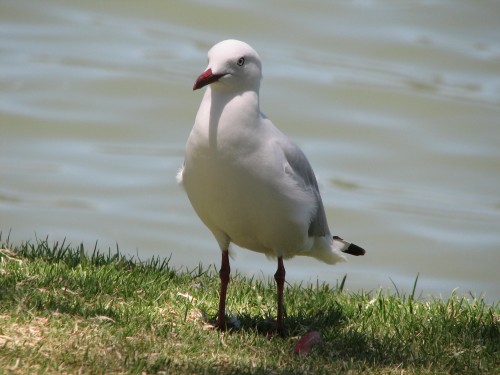Budgerigars
The Budgerigar is a small green and yellow parrot found throughout the inland parts of Australia. Flocks of hundreds and even thousands (if the conditions are right) are a spectacular sight. We’ve only once had a small flock in our garden in Murray Bridge, South Australia. On one occasion while birding near Mildura, Victoria, we witnessed a large flock feeding on the ground. They are a truly spectacular species to see in the wild.
Budgerigars are also a very commonly kept pet throughout the world. Pet birds have a reputation for escaping from aviaries. It is in this context that a wild population became established in Florida. This population once grew to some 20000 or so, but has more recently died out. This wild population now numbers only about 100 individuals.
For more, click here.
Spreading Starlings
The Common Starling is an introduced species in Australia. It has been a very successful immigrant and is now found over large parts of Australia. It has also become one of our major pest species, especially in fruit growing regions. Flocks in their thousands cloud the skies in fruit ripening areas. The cost to agriculture has been, and continues to be, enormous.
The Western Australian Department of Agriculture, however, has been successful – so far – in keeping this pest species out of their fruit growing areas. Recently several flocks have been found 30km further west than thought. Extra efforts are being made to eradicate this new threat.
For more, click here.
Fat Sea Gulls
In a recent report on ABC News it has been found that Silver Gulls are becoming overweight. Over the last two years University of Tasmania researcher Heidi Auman has been studying Silver Gulls in Hobart and on the Bass Strait islands. She has found that the city birds have a higher cholesterol as well as being overweight when compared to their island dwelling counterparts.
Poorer Breeding results
In addition to being fatter, the city dwellers are laying more eggs but there are less chicks surviving. The main reason for their unhealthy state is a poorer diet. The gulls are not getting the correct food as they scavenge rubbish tips – and get fed by people having picnics.
For more, click here. (Sorry – the link no longer works.)
Updated Nov 2013
Rufous Fantail
Elusive bird
One of my favourite Australian birds is the Rufous Fantail, a member of the flycatcher family. As its name suggests, it fans its tail out as is flits to and fro through the forest looking for insects. When the sunlight catches the spread out tail feathers they glow with an amazing deep rufous colour. The photos and illustrations of this species I had seen in books and field guides gave me a deep desire to track down this lovely bird.
My Problem
Now this desire presents a problem to me. I live in South Australia. Rufous Fantails live along the eastern and south eastern coastal areas of Australia. Only infrequently have they been recorded in my home state. That means I have to travel to see this lovely creature. A few years ago, during a holiday in Victoria, I checked out various spots on the Mornington Peninsula where this delightful bird is known to frequent.
No luck
I walked various trails day after day without even a hint of the species I sought. One day I must have walked for several hours without luck. Plenty of other species, but no fantail. Wearily I returned to the car, only to find two of them cavorting merrily around the car! It was enough to make me laugh with joy.
Unexpected Visitor
Today I received an email from a birder in Glebe, inner-west Sydney. He told of how he had a Rufous Fantail fly in through an open door and into his unit. I can’t believe how different birders have such different experiences with the same species. I walked for hours – no days – before I was rewarded with brief glimpses of this species. This fellow comes home from shopping and one flies into his unit. Sometime it’s enough to make one cry.
Purple Crowned Lorikeets
One species I forgot to mention yesterday was the Purple Crowned Lorikeet. Like many Australian parrots and lorikeets, the Purple Crowned is a gregarious, noisy, restless bird found in many parks and gardens in southern Australia. It ranges south of a line from Geraldton Western Australia through to eastern Victoria (but not Tasmania).
Garden Visitor
I can’t say that they are a resident species in our garden – they don’t seem to stay long enough! When the mallee is in flower they come on rushed sorties into the trees in near the house, feed for a while before screeching off to the next feeding ground. Their underwing patch of red distinguishes them from the slightly larger Musk Lorikeet (which is an uncommon species here in Murray Bridge).
Difficult to photograph
These bright green parrots with a prominent red forehead and purple coloured crown are very difficult to photograph – or so I have found. Many times they just go darting overhead as they pass from one clump of trees to another. When they do decide to stop in our garden they are so cryptic in the leaves and flowers of the eucalyptus tree where they are feeding that it becomes hard to see where the leaf ends and the bird begins. I almost dispair of ever getting a clear photo of this species.
Challenge
One of the field guides* I use regularly describes their flight as “bullet-like”. As they go rocketing across the sky past our garden, their “zitt-zitt-zitt” calls seem to challenge me. “Catch us if you can,” they seem taunt as they fly by.
*Pizzey, G and Knight, F “The Field Guide to the Birds of Australia” (Angus and Robertson 1997)

